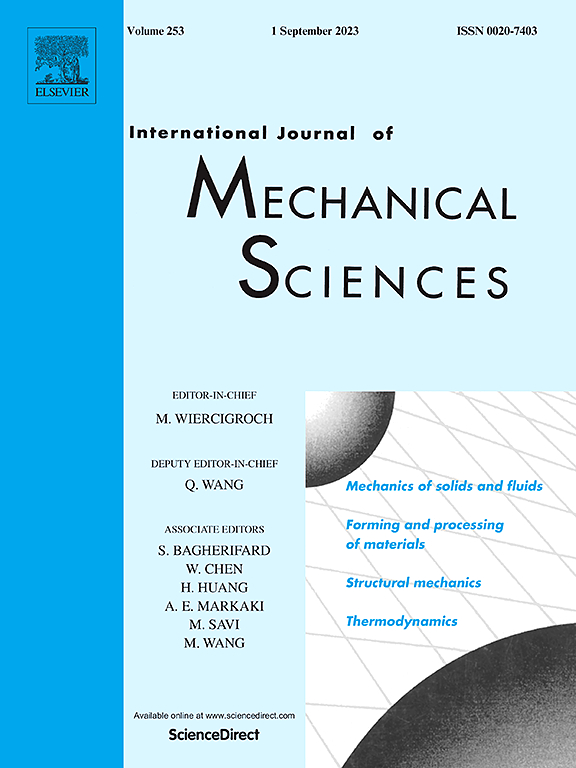应用UEVC超精密加工偏心轴的研究
IF 7.1
1区 工程技术
Q1 ENGINEERING, MECHANICAL
International Journal of Mechanical Sciences
Pub Date : 2025-04-28
DOI:10.1016/j.ijmecsci.2025.110311
引用次数: 0
摘要
偏心轴是机器人和自动化的关键部件,由于其独特的几何形状和SCM420H钢的高硬度和低断裂韧性,给加工带来了巨大的挑战。在加工过程中容易发生脆性损伤,包括断裂和裂纹,这不可避免地缩短了零件的使用寿命,并限制了零件的后续应用。本研究采用超声椭圆振动切削(UEVC)来解决这些问题,开发运动学和数学模型来表征工具-工件相互作用和材料去除。预测结果与实验结果具有较高的相关性(决定系数R²= 0.944,平均相对偏差= 6.39%)。采用扫描电镜(SEM)、电子背散射衍射(EBSD)等表征技术,对传统磨削与UEVC进行了对比实验,分析了其微观结构特征、亚表面损伤机理和材料去除行为。结果表明,与磨削相比,UEVC可使表面粗糙度(Sa)降低91.7%,圆柱度提高73.5%,获得4.77 nm的光滑表面。此外,UEVC有效地抑制了亚表面损伤,将损伤层限制在约1.46 μm,从而防止了微裂纹的形成、材料剥落和典型的磨削脆性断裂。这些发现强调了UEVC在偏心零件精密加工中的优势。本文章由计算机程序翻译,如有差异,请以英文原文为准。

Investigation on ultra-precision machining of eccentric shaft by applying UEVC
The eccentric shaft, a critical component in robotics and automation, poses substantial machining challenges due to its distinctive geometry and the high hardness and low fracture toughness of SCM420H steel. Brittle damage, including fractures and cracks, is prone to occur during the machining, which inevitably shortens the service life of the parts and limits their subsequent applications. This study employs ultrasonic elliptical vibration cutting (UEVC) to address these issues, developing kinematic and mathematical models to characterize tool-workpiece interaction and material removal. The model is validated by a high correlation between predictions and experiments (coefficient of determination R² = 0.944, mean relative deviation = 6.39 %). A comparative experiment between traditional grinding and UEVC was conducted, employing scanning electron microscopy (SEM), electron backscatter diffraction (EBSD), and other characterization techniques to analyze microstructural features, subsurface damage mechanisms, and material removal behavior. The results show that, compared to grinding, UEVC reduces surface roughness (Sa) by 91.7 %, improves cylindricity by 73.5 %, and achieves a 4.77 nm smooth surface. Furthermore, UEVC effectively suppresses subsurface damage, limiting the damage layer to approximately 1.46 μm, thus preventing microcrack formation, material spalling, and brittle fracture typical of grinding. These findings underscore the advantages of UEVC in precision machining of eccentric components.
求助全文
通过发布文献求助,成功后即可免费获取论文全文。
去求助
来源期刊

International Journal of Mechanical Sciences
工程技术-工程:机械
CiteScore
12.80
自引率
17.80%
发文量
769
审稿时长
19 days
期刊介绍:
The International Journal of Mechanical Sciences (IJMS) serves as a global platform for the publication and dissemination of original research that contributes to a deeper scientific understanding of the fundamental disciplines within mechanical, civil, and material engineering.
The primary focus of IJMS is to showcase innovative and ground-breaking work that utilizes analytical and computational modeling techniques, such as Finite Element Method (FEM), Boundary Element Method (BEM), and mesh-free methods, among others. These modeling methods are applied to diverse fields including rigid-body mechanics (e.g., dynamics, vibration, stability), structural mechanics, metal forming, advanced materials (e.g., metals, composites, cellular, smart) behavior and applications, impact mechanics, strain localization, and other nonlinear effects (e.g., large deflections, plasticity, fracture).
Additionally, IJMS covers the realms of fluid mechanics (both external and internal flows), tribology, thermodynamics, and materials processing. These subjects collectively form the core of the journal's content.
In summary, IJMS provides a prestigious platform for researchers to present their original contributions, shedding light on analytical and computational modeling methods in various areas of mechanical engineering, as well as exploring the behavior and application of advanced materials, fluid mechanics, thermodynamics, and materials processing.
 求助内容:
求助内容: 应助结果提醒方式:
应助结果提醒方式:


